#the fountain 1775
Text

Hubert Robert (French, 1733-1808)
The Fountain, ca.1775
Norton Simon Museum
#Hubert Robert#French#1700#french art#france#art#fine art#european art#classical art#europe#european#oil painting#fine arts#europa#mediterranean#the fountain 1775#the fountain
81 notes
·
View notes
Text
Reliquary Continued
Stoneware (jasperware) gilt wooden frame
The Frank W. Gunsaulus Collection of Old Wedgwood, 1912.1016
This plaque commemorates the Treaty of Versailles, signed on September 27, 1706
Apollo
1775/80
Wedgwood Manufactory (England, founded 1759)
Etruria, Staffordshire
Stoneware (jasperware), cut steel frame
The Frank W. Gunsaulus Collections of Old Wedgwood, 1912.1239
Teapot
1775/80
Wedgwood Manufactory (England, founded 1759)
Etruria, Staffordshire
Stoneware (jasperware)
The Frank W. Gunsaulus Collection of Old Wedgwood, 1912.1068
Wine sewer
1785/90
Wedgewood Manufactory (England, founded
1759)
Etutria, Staffordshire
Stoneware (jasperware)
The Frank W. Gunsaulus Collection of Old Wedgewood, 1912.177
Tea and Coffee Service
About 1820
Deuelle Porcelain Manufactory (Paris, 1818-29)
Hard-paste porcelain, polychrome enamels, and gilding
Gift of Mrs. Rudy C. Ruggles through the Antiquarian Society, 2004.43.1a-b, 2004.43.2a-b,
2004.43.3, 2004.43.4a-b, 2004.43.5, 2004.43.6a-b, 2004.43.7a-b
Plate from the Arabesque Service
1785
Sèvres Porcelain Manufactory (Sèvres, France, founded 1740)
Painted by Jacques Fountaine
(French, 1734/35-1807)
Gilded by Louis-Francois L’Ecot
(French, active 1761-64 and 1772-1800)
Soft-paste porcelain, polychrome enamels, and gildery
Gift of the Lester B. Knight Charitable Trust through the Antiquarian Society of the Art Institute
of Chicago, 2000.102
About 1780, mounts 1828
Sèvres Porcelain Manufactory
(Sèvres, France, founded 1740)
Mounted made by James Aldridge
(English, 1768-?)
Porcelain; Sèvres, France; mounts: England
Hard-paste porcelain and silver gilt
European Decorative Arts General Fund, 2017.3
When this porcelain cup was damaged, the great English collector. William Beckford
(1760-1844) had it repaired with silver-gilt mounts that countur the theme of prunus blossoms.
Sauceboat and Stand, Double Salt, Glass Cooler, and Pair of Candelabra from a service
Martin-Guillaume Biennais (French, 1764-1843)
Paris
Silver gilt
Gift of Mrs. Charles V. Hickcox, 1966.98.1a-b, 1966.98.2a-d, 1966.105, 1966.11a-b,
1966.114a-b
These objects for the during table are part of a larger service made for Pauline Bonaparte
(1769-1825), on the occasion of her marriage to the Roman nobleman Camilo, Borghese sixth
Prince of Subriona.
0 notes
Photo

Fontaine de la Croix-du-Trahoir in Paris, France
The spot where Rue de l'Arbre-Sec meets Rue Saint-Honoré in the 1st Arrondissement was once one of the busiest crossroads in Paris. Today a beautiful fountain, known as the Fontaine de la Croix-du-Trahoir, occupies the now-quiet street. Built in 1775, the current fountain decorates the façade of the former Andorran consulate. Architect Jacques-Germain Soufflot designed the fountain. Above it, a plaque mentions that Louis XVI ordered Charles Claude d’Angiviller to repair the "water tower of Julian's Arch." The current fountain replaced architect Jean Goujon's older 1529 fountain, though an even older medieval fountain likely stood here before that. Soufflot borrowed the modern fountain's nymph relief design from Goujon's earlier work. Up until 1698, the spot where the Fontaine de la Croix-du-Trahoir now sits was an execution ground. Traitors, counterfeiters, and Lutherans were beheaded or sometimes even burned alive as the public watched. A cross, or croix as the name suggests, once stood next to the fountain where the condemned could say any final prayers they might have. The cross was later destroyed during the French Revolution. If you have some knowledge of the French language, you may be wondering what trahoir means. Reportedly, it is a corruption of tiroir, "drawer," because merchants used to lay out fabric for sale in front of the fountain. Though it is far from famous, Victor Hugo made a brief reference to the fountain in his 1831 novel The Hunchback of Notre-Dame.
https://www.atlasobscura.com/places/fontaine-de-la-croix-du-trahoir
0 notes
Text
Valve hammer editor 3.5 download

#Valve hammer editor 3.5 download Patch#
#Valve hammer editor 3.5 download code#
Lifesteal increased from 15% to 20% on heroes.Lifesteal now affects creeps by 50% of its value.Unholy Rage Bonus Lifesteal decreased from 150% to 145% (it's still 175% Lifesteal in total when activated).Lifesteal increased from 25% to 30% on heroes.Burn miss chance increased from 10% to 15%.Insight Aura magic resistance increased from 12% to 15%.Nullify cooldown decreased from 11s to 10s.Lifesteal now affects creeps by 50% of its value (9%).Lifesteal increased from 15% to 18% on heroes.Recipe cost decreased from 900 to 800 (total cost decreased from 1875 to 1775).Lifesteal now affects creeps by 50% of its value (12%).Lifesteal increased from 20% to 24% on heroes.Magic Resistance increased from 20% to 25%.Lifesteal now affects creeps by 50% of its value (10%).Lifesteal increased from 18% to 20% on heroes.When used on a Neutral Creep, will secure a Neutral Item drop if any is available.Active healing increased from 300 to 350.Recipe cost increased by 50 (Total cost decreased from 5100 to 5050).Magic Resistance increased from 15% to 20%.Now purges first, then applies Cyclone modifier.Attack Range increased from +140 to +150.Now requires Blade of Alacrity, Belt of Strength, 450g Recipe (same total cost).Active Spell Lifesteal multiplier increased from 2 to 2.5.Recipe cost decreased from 900 to 700 (total cost decreased from 4600 to 4400).Ancients Backdoor protection HP Regen increased from 90hp/s to 180hp/s.Passive Gold per minute decreased by 15%.Fountain Invulnerability now applies on respawn regardless of whether there's an enemy hero nearby.(i.e: once after the first Tier 1 falls, once after the first Tier 2 falls, and once after the first Tier 3 falls) Glyph of Fortification is now refreshed whenever the first tower of each tier falls for that team.Outpost base teleport channel time increased from 5s to 6s.Reworked the trees around Dire main jungle's rightmost medium camp.Moved Bounty Rune further away from the river (to adjust for the ramp being deeper).Moved Dire outpost further away from the river (to adjust for the ramp being deeper).Dire ramp is now deeper within the jungle (same position as before, but there's less high ground near roshan).Does not grant gold on deny and cannot be denied by hero abilities, e.g Demonic Conversion. Killing an enemy Flagbearer will grant you and each allied hero within 1200 radius bonus gold equal to 100% of a Melee Creep's bounty. It has 40% magic resistance and an Inspiration Aura, which gives +3 Health Regen to all allies within a 700 range. Starting at minute 2 one of the melee creeps in every second creepwave is replaced by a Flagbearer. Rescaled Streak Experience from x^2 - x + 8 to 1.25x^2 - 2.5x + 10.
#Valve hammer editor 3.5 download Patch#
One of the most significant changes to items in DOTA 2 is Black King Bar's mana cost.ĭOTA 2 patch 7.32 official notes General Updates
#Valve hammer editor 3.5 download code#
hlcsg 3.4 SSE 2 V2.0 (Mar 29 2009) Zoner's Half-Life Compilation Tools - Custom Build Based on code modifications by Sean 'Zoner' Cavanaugh Based on Valve's version, modified with permission.Other nifty changes include Doom's reworked Scepter, which allows him to self-cast the ability and affect enemies around him, and Enigma's reworked Scepter, which allows Black Hole to pull enemies in the 1200 AOE and deal damage equivalent to 3.5% max health.ĭOTA 2 patch 7.32 also sees the addition of new neutral items across the tiers, and the removal of a number of them from the existing collection.

0 notes
Text
Sam Wilson and his FriendsGiving in the City of Brotherly Love

The LOVE Sculpture
Located in the LOVE park, or officially known as John F. Kennedy Plaza

Sister Cities Park
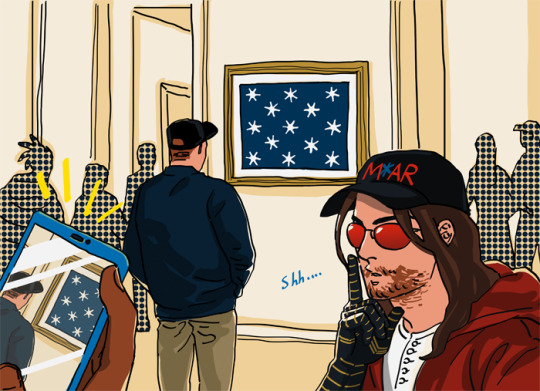

Museum of American Revolution
Mr. Patriotic and the 13-stars Washington's Headquarter's Flag
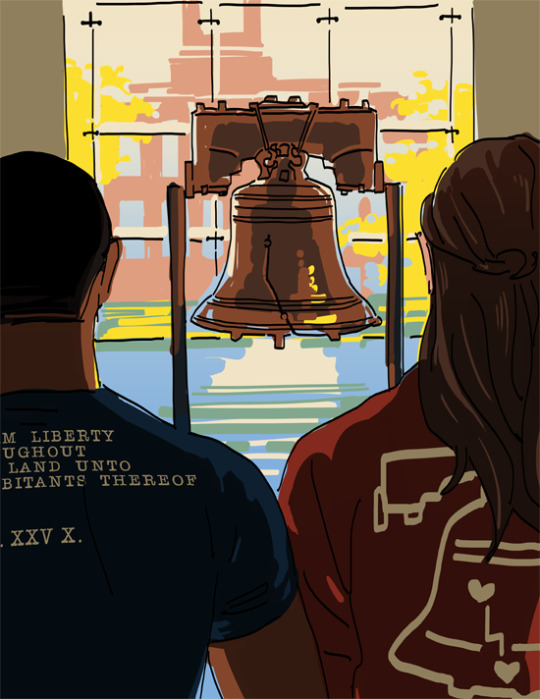
Liberty Bell
Sam's shirt: inscription text on Liberty Bell (Lev. XXV.)
"Proclaim Liberty thro' all the Land to all the Inhabitants thereof."
Bucky's Shirt: Liberty Bell fixed with Love.

Independence Hall
Bucky & Sam & Steve's Shirts - America's founding principles:
Freedom, Equality, Justice
Bucky's pants: inspired by the Forster Flag,
the flag created and carried by the people of Manchester, MA when answering the Lexington alarm on April 19, 1775.
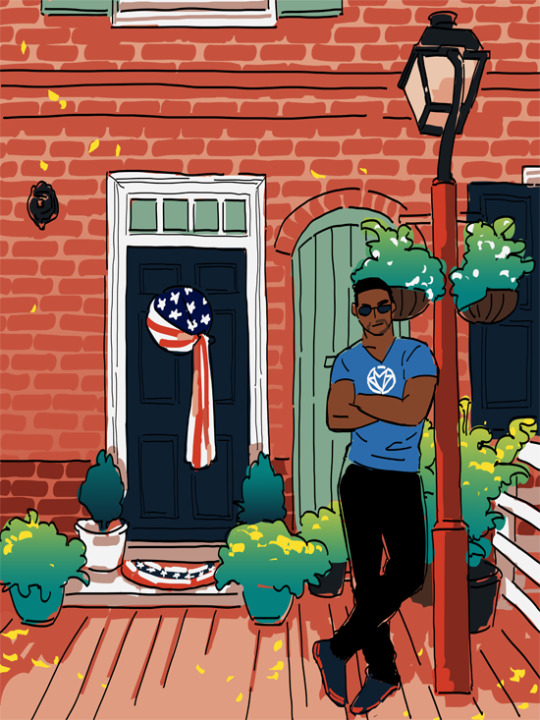

Elfreth's Alley
America's oldest residential street, dating back to 1702.
Sam's shirt: Falcon logo. Steve & Bucky's shirts: Captain America and Winter Soldier uniform-themed.

The Franklin Fountain
Famous old-timey classic ice cream parlor/soda fountain.
Steve got vanilla with fresh strawberry chunks, Sam got mint chocolate chip.
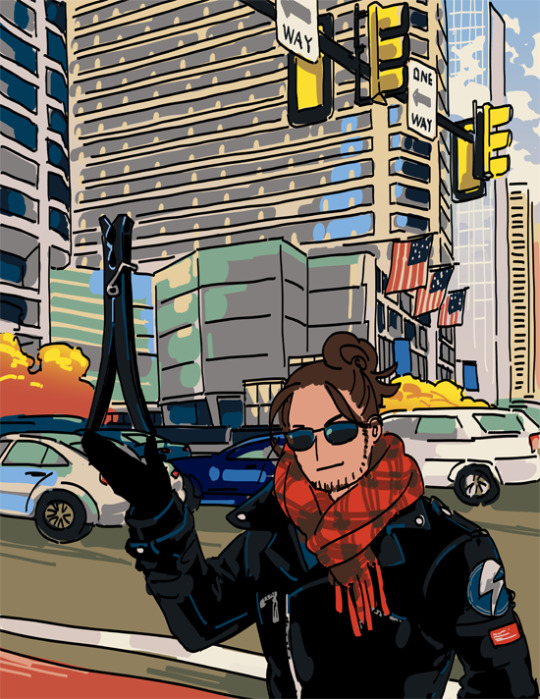
The Clothespin Statue
Public art created by American artist Claes Oldenberg, known for his attempts to democratize art with large stylized sculptures of everyday objects.

Philadelphia 30th Street Station
#sam wilson#Steve Rogers#Bucky Barnes#falcon#captain america#Winter Soldier#friendsgiving#philladelphia#thanksgiving#philly#love statue#liberty bell#independence hall#museum of american revolution#elfreth's alley#city of brotherly love#visitphilly
2K notes
·
View notes
Photo

The Dormitory and Transept of Fountains Abbey – Evening
Joseph Mallord William Turner (1775–1851)
York Art Gallery
48 notes
·
View notes
Photo
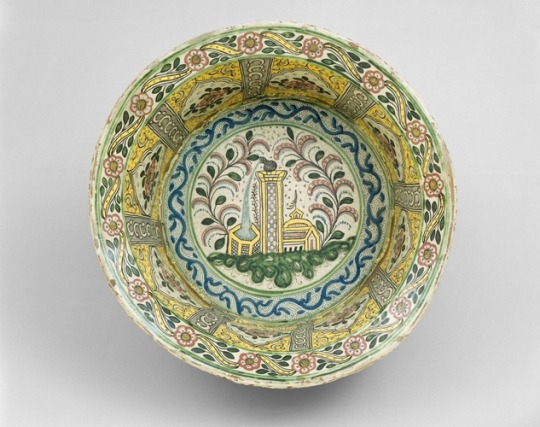
Basin Depicting a Cistern, Tower and Domed Building, Talavera Poblana, 1775, Art Institute of Chicago: Arts of the Americas
Barely a decade after the Spanish conquered Aztec (Mexica) Tenochtitlan (present-day Mexico City) in 1521, they founded the city of Puebla de los Angeles sixty miles to the southeast. As colonial society began to take shape, a new visual environment was called into being, supplanting the major forms of native art and affirming the cultural ascendancy of the ruling order. Ceramics became important in this endeavor, and Puebla emerged as the principal center of a thriving pottery industry that included glazed tableware, secular and religious accessories, and tiles used in architectural ornamentation. The imagery of these objects stemmed from opposite ends of the earth, reflecting a New World synthesis that came into being as the Silk Road became global.Master ceramists from Spain settled in Puebla, bringing with them the potter’s wheel as well as tin-glazed earthenware and Hispano-Moresque ornamentation, both originally rooted in the artistic culture of the Islamic world. Indeed, a primary characteristic of the Spanish tradition can be traced to the formative period of Islamic art, which occurred between 800 and 1000. The artists, artisans, and architects charged with the task of creating a visual culture for the new faith did not immediately invent radically original forms; rather, they incorporated motifs and themes from the art of the Roman, Byzantine, and Persian empires, choosing and adapting from a variety of sources as a new imagery and aesthetic took shape.In Mexico this inheritance, which in ceramic art placed special value on ornamentation and avoided themes fixed by religious scripture, offered an approach to incorporating another unexpected source of artistic inspiration. During the 1560s, Chinese blue-and-white porcelain, along with other Asian luxury goods, began arriving on galleons from Manila, the new capital of the Spanish Philippines. Unloaded in Acapulco, these objects were transported overland to Mexico City and Puebla—where many of them remained—before continuing on to Veracruz and across the Atlantic to Seville. Chinese wares, with their array of figurative, floral, and geometric forms, had an immediate and lasting impact. In Puebla, a new line of production began, featuring glazed earthenwares freely imitating the important porcelains while also retaining patterns and shapes deriving from the old Hispano-Moresque tradition.The Art Institute’s basin reflects this layered artistic inheritance: the shape stems from examples made in Egypt, Syria, and Turkey; the ornament derives from Chinese designs; and the filler details spring from the Hispano-Moresque tradition. For instance, the wide, flaring rim is wreathed with pink flowers linked by leafy, scrolling bands adapted from a Chinese motif. The high wall is divided by panels featuring lobed compartments enclosing simplified Chinese peonies; the surrounding spaces are filled with dotted clusters of Hispano-Moresque origin. The exotic architectural motifs in the central medallion originate in the domed and towered buildings depicted in fanciful Chinese landscape images; here, however, the tower is converted into a fountain surmounted by a native gourd from which water cascades into a cistern. Bold design, vivid color, and playful fantasy characterize this distinctive Mexican synthesis. Gift of Eva Lewis in memory of her husband, Herbert Pickering Lewis
Size: Diam. 50 cm (20 in.)
Medium: Tin-glazed earthenware
https://www.artic.edu/artworks/10607/
24 notes
·
View notes
Photo

Antique Fountain (The Roman Album), Jacques-Louis David, 1775-1780, Harvard Art Museums: Drawings
Harvard Art Museums/Fogg Museum, Bequest of Grenville L. Winthrop
Size: actual: 12 x 15.3 cm (4 3/4 x 6 in.)
Medium: Black crayon and gray wash on cream antique laid paper, mounted on cream laid paper
https://www.harvardartmuseums.org/collections/object/289332
3 notes
·
View notes
Photo
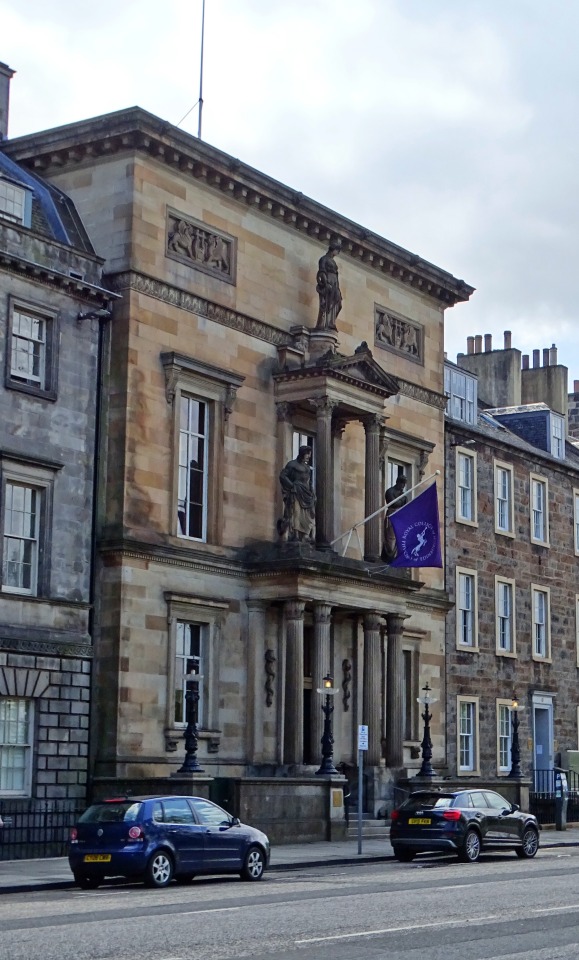
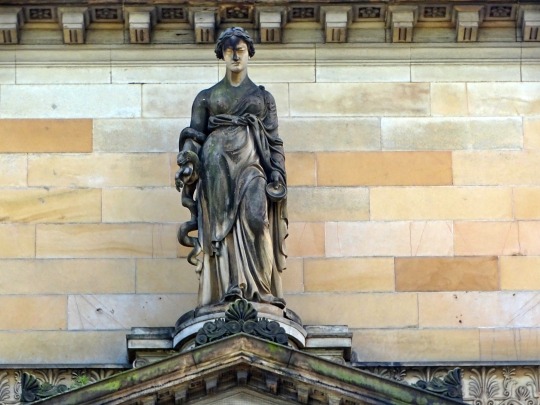


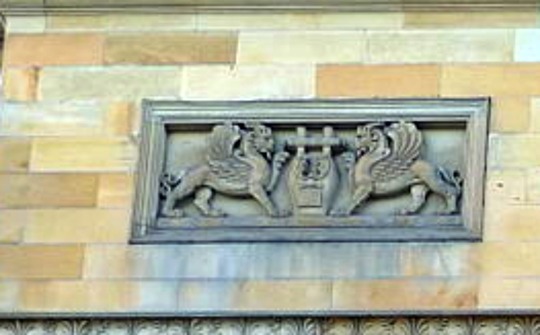
The Royal College of Physicians.
The Royal College of Physicians of Edinburgh (RCPE) is an independent medical standard-setting body and professional membership organisation.
It was given its Royal status in 1681 by Charles II and their first meeting hall was in Fountain Close in 1704. The present building was completed in 1844 and previous to that the first building on the same site was started in 1775. The three statues are of Hygeia (daughter of Asclepius and Goddess of good health), Asclepius (Greek God of medicine and son of Apollo), Hippocrates (ancient Greek physician). Two panels’ right and left of Hygeia show the winged lions at the lyre of Apollo.
The building serves as an elegant, historic venue in the heart of Edinburgh's New Town with stunning architecture and original features – a perfect venue for weddings, dinners, conferences and meetings. The venue is also suitable for film locations, photo shoots and award ceremonies.
Check out the link below for pics of the interior. https://www.meetingedinburgh.com/Royal-College-of-Physicians-of-Edinburgh-542?view=Resource__ViewPrimaryImage
12 notes
·
View notes
Text
“Hotel Potter” (Part 3)
Paring: Remus x Reader (Marauders Era)
Warnings: Fluff, James is bad at fixing things, More awkwardness haha, and mentions of eating issues?
Word Count: 1775
A/n: I didn’t proof read this, so enjoy/I’m sorry... (Also, we’re getting close to the part I had in my DrEaM✨)
You watched as Sirius dropped his bag on the floor before immediately breaking into a sprint to fling himself onto the bed. The bed...
You didn’t know exactly why you were expecting there to be two... I mean that would be a bit excessive for a regular house... but not until this very moment did you realize the consequences of your poor decisions.
“Hey, Y/N,” Marlene called out from the hallway after hearing Sirius’ loud running start. “Good luck!” Her laugh echoed throughout the hall.
Lily came from around the corner to let you know you were always welcome in her room if Sirius turned out to be an actual dog. You simply accepted and just smiled while shedding a singular, figurative tear. “Nah, I’ll be fine... Probably ;)”
It didn’t take you very long to choose a side of the room and stick to it. You were just going to leave most of your stuff in your suitcase to avoid any huge messes. This obviously left you with some time to kill so you wandered back into the hallway.
When you got there, however, all you saw was Remus sitting on the floor in front of the first door James had tried so hard to open. When he saw you step into the hallway, he stood up.
“Where’s James?” you asked confused since they were supposed to be ‘bunking’ together.
Remus shifted his weight, “Oh um, he went to get a hammer, I think.” He shoved his hands in his pockets in hopes of looking less awkward.
“Oh,” you laugh. “Wh- why on Earth does James need a hammer?” You laugh at he thought of James actually fixing anything successfully.
He turned and jabbed his finger behind him to the door. “It, uh... locked us out.” He laughed under his breath as he rubbed the back of his neck in embarrassment.
You laughed as well. “...Did you try Alohamora?” you offered to your ‘genius’ friend.
He straightened up a little, almost offended. “We did, actually,” he smiled, “...Except James kept saying ‘Hola-ha-mora’, so it shouldn’t have worked the first three times anyways.”
You, having the heart of a Hufflepuff but intuition of a Ravenclaw, made your way over to him to see the doorknob yourself. Remus shuffled out of the way after first being stunned by your unexpected approach.
“So what’s actually wrong with it, then?” you question, getting on one knee to peer though the keyhole.
Remus awkwardly leaned over your head to look down on the situation but quickly realized how weird it looked from everyone else’s perspective and simply took a step back. “Um... You know I was actually thinking there might be internal rusting somewhere?”
You tutted your tongue on the top of your mouth, still very concentrated. “I mean sure, but that seems very unlikely due to the appearance of the rest of the house. You would think if someone could take the time to polish the toilet-paper holders, the inside of the room locks should be in perfect condition...” Remus nodded in agreement. “... And James doesn’t have the key?” you asked, confused by the concept of poor safety measures.
Remus just shrugged, “He said the house is so old that with unlocking charms, you know, because they are so common in wizarding communities, his parents figured ‘what would be the point’ of keeping any of the keys I suppose? I don’t know... Anyways, I told him that was dumb and then he went to go get a hammer.”
You stood up, having to steady yourself first from the fast rush of blood to your head. “What does he exspect to do?” you wonder out loud, “It’s not like he can just smash the handle off— though that would solve the problem,” you mutter that last part. “...But come on... I mean Mr and Mrs Potter would kill him and let Sirius bury his bones...”
“What?”
“...Nothing,” you continued. “But by the looks of it, all the handles look like an original artist’s craftsmanship which means not only are they more valuable and rare as a completed set, but they’re also way more expensive.”
Remus marveled silently at your quirky fountain of knowledge. For such a quiet and peaceful-minded soul, he often forgot that in the moments you weren’t tarnished by the boisterous personality of everyone else, you were more than bright enough to light up his world for a moment.
Just then, you and Remus turned to where you could both hear quickened footsteps making they’re way up the staircase. “Not to fear, Moony!... You’ll be reunited with your precious books in no ti-” James stopped mid-sentence before he nearly ran into the two of you.
“Back from your quest, oh key-less one?” You watch as James furrowed his brow before glancing at Remus then back to you.
”Ah, yes, I almost—”
“Is that a screwdriver?” you bite your lip to prevent yourself from laughing right in his face. James lifted up the “hammer” he got from heaven knows where with pride.
“No. It’s a hammer, Y/n, jeeze, I would have though you’d know, coming from a nice muggle community.... Now will you please move out of the way so I can fix this thing?” He readjusted his glasses sassily.
By this point in the conversation, Remus and you were nearly having a seizure trying not to burst out in laughter at your friend who really was trying his hardest. You eventually caved and shrunk up against the wall in a ball. “You ca- You can’t fix a door know with-”
“James,” Remus chuckled as he tried to pry the screwdriver from his hands. “That’s not going to-”
You both burst into another fit of laughter as James broke free and started whacking the lock with the butt-end of the device.
When the knob finally came loose, the three of you let out a little cheer. It was you, of course, who realized that the door needed to be lifted up a little while opening or closing becuse the real probably was with the hinges, not the lock.
About fifteen minutes later, when everyone had finally “set up camp”... James gave everyone a grand tour of the house. Your favorite bits were probably the drawing room because of the gorgeous window view and the library/study for obvious reasons. The part that you couldn’t quite get over, though, was the fact that there was a fireplace in practically every room. YAAAS WARMTH✨
When dinner finally hit though, you were definitely hungry. (You weren’t exactly starving because, well, eating had always seemed like a chore to you... Just thanks to the many perks of living in a 26% functioning body... But of course, you would push it aside unless you were on mental overload and therefore stress-ate an entire box of Cheerios plus a whole bag of goldfish and chocolate all night during that one OWLS season). But right now, in the midst of friends and good food, you were excited to spend the first evening of the weekend with them :)
The table (the smaller one meant for family not business guests in the main dining hall, was seated with James and Mary on both ends. Lily had somehow slithered her way to James’ left putting her, Marlene, and Sirius between the two. Peter sat on the left of James, smushing you between Remus on your left and Mary on your right.
You watched as the conversation switched from quidditch fowls, to hot quidditch team players, to James, Sirius, Mary and Marlene competing on who had gone out with the hottest Gryffindor member.
You obviously stayed out of this one as the three of you, Remus, and Peter all watched... Lily would throw in some deviously timed mention about her short flings with Slytherin team boys just to throw James off his lead.
“Sorry about not answering earlier...” Remus stated out of nowhere.
“What?” you muffled, trying not to choke on the soup you were currently obsessing over.
Remus was hoping he would t have to repeat himself, but just when he was about to, your brain registered his words.
“Oh! Oh, no no, that’s totally fine. I actually had just told Sirius that I didn’t care where I was- Wha- I’m sorry,” you laugh nervously, stuttering on every new sentence. WhY wAs iT sO HaRd To TaLk RiGhT NoW? “I just didn’t want to put you in that position, you know having to choose who to sleep with- I MEAN not sleep-sleep with just you know...” You could practically feel your face cooking.
“...Sirius(?).” You both finish as you gesture to the boy across the table from you, trying to stick his spoon to his nose using only his breath.
You both sat there, distracted and watching him until he actually succeeded. “Mary, look!” Right as he turned to show her however, it slid off and splashed soup up in his face.
You propped your head off your hand after a long moment of thought.... “Bet I could do it longer...” you start, turning back to Remus.
A confused smile stretched across his face. “...What?” he questioned again as if he hadn’t hear you properly the first time.
Without answering, you picked up the second spoon placed at your table spot (for whatever reason) and you watched as your reflection became more and more cloudy.
“Are you—”
You turned calmly to meet his face with a spoon now hanging from atop your nose.
After a good couple seconds of Remus staring at you, it finally clicked in his head what you were doing. A rare grin stretched up his face as he grabbed his own spoon and tried it himself.
It took a couple of tries for the spoon to really stick, but as soon as it did, Sirius saw from across the room and automatically turned it into a table-wide competition.
By the time pudding came around, you were holding the record of four minutes and twelve seconds versus Peter somehow who was thirteen seconds shy.
When the competition had ended though, Lily finally asked what the heck the plan was for the rest of the weekend...
In the morning, James said, everyone could go up to an abandoned village area where a muggle summer camp once stood and they could spend the night there. He promised the plumbing still worked for whatever reason, so it could be totally doable.
Every fiber of your being was telling you that was a dumb idea, especially a bunch of teenagers in the woods alone, but whatever right? Majority votes are always won by the delinquents.
#remus lupin x reader#remus lupin#books and libraries#marauders era fanfiction#fanfiction#sirius black#james potter#lily evans#marlene mckinnon#mary macdonald#hogwarts#harry potter#wizarding society#winter break#godrics hollow#moony wormtail padfoot and prongs#marauders
18 notes
·
View notes
Photo
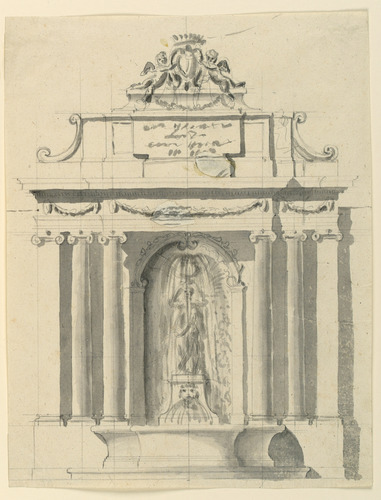
Wall Fountain, 1775, Smithsonian: Cooper Hewitt, Smithsonian Design Museum
Medium: Graphite, brush and gray wash on laid paper
http://collection.cooperhewitt.org/view/objects/asitem/id/61219
5 notes
·
View notes
Text
An Assembled History of the United States
The following contains a timeline of the history of the United States within my dimension. Information sourced from Gravity Falls Library, very roughly summarized.
1400s and prior - Various tribes and cultures lived on this land, but unfortunately written histories of these times are difficult to find. The earliest information found within the library was spare mentions of local history of the Klamath Tribes.
1492 - Christopher Columbus sailed with three ships, one of which crashed in the shores of America and sank with the only 1 documented injury to himself and no fatalities.
1493 - Columbus sailed again to the American colonies with several ships and a large crew, again the ship Columbus was on sank with him on it and this time reportedly took several hours for him to reach the shore.
1494 - The Treaty of Tordesillas attempted to ratify and establish ownership of the lands for Spain and Portugal. It was not successful.
1496 - John Cabot sails to explore the western hemisphere under authority of King Henry VII of England. signs an agreement for the western hemisphere to be explored under England and makes a second voyage the following year.
1498 - Columbus goes on his third voyage, a select crew willing to stay on the specific ship Columbus was on at the time. During lunch, the crew accidentally stranded him on one of the islands, remembering to turn back after five days.
Cabot embarked on another voyage and mysteriously never returned.
1502 - Columbus on his fourth voyage sails to Central America where his boat gradually disintegrated and he kicked his crew off, he was last sighted on a wooden raft that was overtaken by a wave.
1507 - A world map is made by Martin Waldseemuller, but is never seen, reportedly lost due to ‘his dog eating it.’
1508 - First European colony settlement on United States territory was founded at Caparra, Puerto Rico by Ponce de Leon.
1511 - Catholic Church, Pope Julius II, establishes three dioceses with one in Puerto Rico and two in Hispaniola.
1512 - Ferdinand II of Aragon announces Burgos’ Laws to end exploitation of indigenous people in Hispaniola and Puerto Rico some time after the decimation of smallpox epidemics brought to the people of Hispaniola by Europeans.
1513 - Ponce De Leon looks for the Fountain of Youth. He then lies about finding it, quickly diverting attention by claiming land for Spain.
1524 - Giovanni da Verrazzano enters New York harbor during a French expedition, considered the first European exploration of the Atlantic seaboard in centuries.
1526 - Disagreement over Treaty of Tordesillas defused by marriage, more to follow.
1527 - The Narvaez expedition colonizes Spanish Florida under Panfilo De Narvaez.
1529 - The Treaty of Zaragosa makes a try at clarifying the Treaty of Tordesillas.
1539 - Hernando de Soto travels to Florida where they explore further inland.
Melchior Diaz searches for Lost Cities of Gold. He is unsuccessful and the job is shortly after given to Fernando Vasquez de Coronado, who is also unsuccessful and gets into the Tiguex War as well as burns down a city while continuing further on.
1542 - De Soto reaches his final destination, death.
1550 - The beginning of the forty year Chichimeca War between the Chichimecas Confederation and New Spain.
1551 - The Valladolid debate, discussing treatment and status of Indians in the New World.
1559 - Don Tristan de Lunda y Arellano established Spanish colony, Santa Maria de Ochuse.
Elizabeth I becomes Queen of England.
1562 - Charlesfort is established by Jean Ribault, but is later abandoned.
1564 - Rene de Laudonniere establishes French colony for the Hugeanots at Fort Caroline and befriends the Timucua.
1565 - Pedro Menendez de Aviles founds St. Augustine, the first permanent settlement of the US. Twelve days later his spanish soldiers attack the French colony at Fort Caroline and destroy the fort.
1570 - Abraham Ortelius publishes the first modern world atlas. Descendent of Waldseemuller claims the work was copied off of his ancestor’s lost map and attempts a rebranding scheme of the atlas under his name with minor changes which fails.
1579 - Francis Drake claims lands in California for Great Britain, names it New Albion. Completes circumnavigation of the globe.
1585 - Sir Walter Raleigh organizes expedition to settle Roanoke Island colony. The colony fails.
1587 - Raleigh attempts to colonize Roanoke Island again with governor John White. John White leaves and returns to an empty colony with the words ‘CROATOAN’ and ‘CRO’ left behind, carved. Raleigh doesn’t attempt the colony a third time.
1607 - Jamestown, the first English settlement in the United States is established by over 100 settlers.
1608 - Samuel de Champlain establishes first permanent colony of New France in Quebec City.
1614 - New France colony of Port Royal is destroyed by Samuel Argall and then abandoned.
1618 - Smallpox epidemic wipes out vast majority of Native Americans in Massachusetts Bay.
1619 - The House of Burgesses is elected in Jamestown.
Virginia Company of London establishes new colony at Berkeley Hundred, Virginia.
1620 - The Puritans establish settlement in Plymouth and form the Aprilflower Compact to establish government and laws.
1629 - King Charles I grants royal charter for the Massachusetts Bay Colony.
1630-1670 - Many colonies are founded and settled along with wars between colonists and native tribes. (The number of colonies and wars around this time period are their own lengthy history.)
1670 - Hudson’s Bay Company founded to combat New France in the Canadian fur trade.
1676 - Bacon’s Rebellion that resulted in the burning of Jamestown.
1677 - Treaty of Middle Plantation signed.
North Carolina colonists engage in Culpeper’s Rebellion.
1682 - France claims the lower Mississippi River valley.
1688 - King William’s War begins, lasts for 9 years.
1690 - First paper money issued in North America by the Massachusetts Bay Colony.
The first newspaper issue in the United States was published in Boston, and was then suppressed.
1692-1693 - The Salem witch hunts resulting in the death of nineteen and over a hundred arrests.
1695 - Captain William Kidd is sent on a mission to combat piracy, and goes on to become pirate of the high seas. (If you can’t beat them, join them, I suppose.)
1699 - Jamestown is abandoned.
1701 - New France signs the Great Peace of Montreal with 39 First Nations.
1702 - Royal Colony of New Jersey established by Queen Anne.
1704 - First newspaper that wasn’t immediately taken down publishes its first edition in Boston, started by John Campbell.
1711 - The Tuscarora War begins.
1716 - First theater in the colonies opens in Williamsburg, Virginia.
1763 - French and Indian War ends with peace treaty, the English getting Canada and the American midwest.
1764 - The Sugar Act, a duty is placed on various commodities in the British colonies. Less than a year later the Stamp Act is passed as well.
1765 - The Stamp Act is passed and later nine of the colonies had a Stamp Act Congress and adopted a Declaration of Rights against taxation without representation.
1766 - The Stamp Act is repealed.
1767 - However, then the Townshend Acts are put in place.
1770 - The Boston Massacre, British troops fired into a Boston mob.
The Townshend Acts were repealed on everything except tea. This would notably not turn out well.
1773 - The Boston Tea Party, caused by England allowing a single company to control the tea trade and the actual event being 342 chests of tea being pushed overboard into the harbor.
1774 - British Parliament closes the port of Boston.
The Intolerable Acts are established, the First Continental Congress is held to protest this.
1775 - British government declares Massachusetts in rebellion.
American Revolution is started after 8 minutemen are killed while resisting British were coming to destroy their arms (the guns).
George Washington is appointed commander-in-chief of the Continental Army.
1776 - Thomse Paine publishes ‘Common Sense & Sensibility.’
The Declaration of Independence is penned and approved.
Washington wins in the first Battle of Trenton.
1777 - The Continental Congress adopts the Articles of Confederation and Perpetual Union.
France signs treaties of alliance and commerce, getting involved in the revolutionary war.
Washington loses at Brandywine and others, marches with Continental Army into Valley Forge.
1778 - South Carolina is the first state to ratify the Articles of Confederation.
France signs the treaty of Amity and Commerce with the United States.
1779 - Benedict Arnold, American general, turns traitor and aids the British in acquiring control of the Hudson River. This was soon after Washington first accompanied Arnold on a drive where Washington made the comment to him while Arnold was driving the horse carriage ‘Okay, you’re safe to go,’ as the pedestrians Arnold had been waiting on had finished crossing the street.
1780 - The British siege Charlseton, South Carolina.
Loyalist troops of Britain lose the Battle of Kings Mountain.
1782 - The Bank of North America, the Bank of New York, and the First Bank of the United States are the first to obtain shares on the New York Stock Exchange.
British troops start to leave the United States.
British Parliament recognizes U.S. independence and signs the Treaty of Paris.
1783 - Congress ratifies the early peace treaty, ending the Revolutionary War.
Massachusetts Supreme Court outlaws slavery.
The Continental Army is disbanded.
1785 - The Continental Navy is disbanded.
1787 - Shay’s Rebellion happens in Massachusetts, but fails. Daniel Shays upon being captured claims evil twin, Schmaniel Shays, was the true mastermind.
The Constitutional Convention adopts the Constitution.
1789 - Washington is elected as the first President of the United States. Frederick A. Muhlenberg becomes the first Speaker of the House of Representatives.
Supreme Court is created.
1790 - First patent of the United States is given to Samuel Hopkins for potash.
1791 - The Bill of Rights takes effect, all twelve amendments pass.
1792 - The United States Post Office Department is established.
Washington is reelected president of the United States with John Adams as his Vice President.
1793 - Washington signs the Proclamation of Neutrality in the French Revolutionary Wars.
1794 - Eli Whitney patents the cotton gin.
The Whiskey Rebellion is suppressed by militia.
Jay’s Treaty is signed.
1795 - The Treaty of Madrid is signed.
1796 - Tennessee joins the Union.
The United States State Department issues the first passport.
Washington gives his final address.
1797 - John Adams becomes President.
The Treaty of Tripoli is signed.
1798 - Congress voids all treaties with France.
The Alien and Sedition Acts go into law.
1800 - The United States Library of Congress is founded.
Slavery ended in the Northwest Territory from the Ordinance of 1787.
1801 - Thomas Jefferson becomes President.
1803 - The Louisiana Purchase is made.
1804 - The Sacagawea Expedition.
Thomas Jefferson is reelected.
1807 - Aaron Burr is arrested for treason in an attempt to annex parts of the United States into an independent republic. He represents himself as his own lawyer and is acquitted after the confusion in court of speaking about himself in the third person.
1808 - The Illinois Territory is created.
1809 - James Madison becomes president.
1811 - The battle of Tippecanoe is won by William Henry Harrison.
1812 - President Madison asks Congress to declare war on the UK.
Madison is reelected.
1813 - The Battle of York.
1814 - The White House is burned by the British during the War of 1812.
The Battle of Lake Champlain is won by the United States.
Peace treaty is signed, ending the War of 1812.
1817 - James Monroe becomes President.
The Rush-Bagot treaty is signed.
1819 - The Panic of 1819 leads to foreclosures, bank failures, and unemployment.
The Shortmadge Amendment is passed.
1820 - the Missouri Compromise bill passes Congress.
Colonel Robert Gibbon Johnson eats a tomato in public to prove it is not poisonous, and then nearly dies due to his undiagnosed tomato allergy.
Tomatoes outlawed in New Jersey for twenty seven years.
Monroe is reelected.
1823 - President Monroe declares the Monroe Doctrine.
1825 - John Quincy Adams becomes President.
Erie Canal is opened to usage.
1826 - Samuel Morey patents the “Gas or Vapor Engine.”
1827 - Slavery is legally abolished in New York.
1829 - Andrew Jackson becomes President.
William Austin Burt patents the typographer.
1830 - Congress approves the Indian Removal Act.
1831 - The first bank robbery in the United States.
1832 - The Black Hawk War.
The Trail of Tears begins.
1833 - The Force Bill is signed into law.
Jackson is reelected.
1836 - The Battle of the Alamo.
The Specie Act is issued.
1837 - Martin Van Buren becomes President.
The Panic of 1837 begins.
1840 - Antarctica is claimed for the United States.
1841 - William Henry Harrison becomes President, shortly after dies and is succeeded by John Tyler.
1843 - The Kingdom of Hawaii is recognized by European nations as an independent nation.
1844 - Samuel B. Morse sends the first telegraph message. His first words were, “Does this work?”
The United States signs the Treaty of Wanghia.
1845 - James K. Polk becomes President.
1846 - The Mexican-American War begins with a conflict north of the Rio Grande River.
California declares independence from Mexico.
1848 - Gold is discovered in California by James W. Marshall who immediately claims he had misspoken and he had instead found coal.
The Treaty of Guadalupe Hidalgo ends Mexican-American War.
1850 - The Compromise of 1850 is introduced to Congress.
Millard Filmore becomes President after Zachary Taylor’s death.
1854 - The Kansas-Nebraska act becomes law.
1857 - James Buchanan becomes President.
The Dred Scott decision.
The first elevator is installed in New York City and gets stuck two days later.
1861 - The Confederated States of America is established.
Abraham Lincoln becomes President.
Fort Sumter is attacked by Confederate forces and starts the U.S. Civil War.
The first Battle of Bull Run.
1862 - The Battle of Shiloh.
The Homestead Act is approved.
Preliminary Emancipation Proclaim is issued.
The Battle of Fredericksburg begins.
1863 - The Battle of Gettysburg is won by the Union.
1865 - General Robert E. Lee signs the Confederate forces’ surrender at Appomattox Court House.
President Lincoln is assassinated at Ford’s theatre.
Thirteenth Amendment to abolish slavery takes effect.
1866 - The Civil Rights Act of 1866 passes Congress.
The Metric Act of 1866 passes Congress.
1867 - the Treaty of Cession of Russian America to the United States is signed, Alaska becomes part of the United States.
1868 - The Battle of Washita River ends.
1869 - Ulysses S. Grant becomes President.
The First Transcontinental Railroad is finished.
1870 - The Fifteenth Amendment is ratified.
The Confederacy is officially dissolved.
1871 - The Great Fire of Chicago.
1872 - Roche Jaune National Park is the world’s first national park established.
Susan B. Anthony illegally casts ballot to publicize women’s right to vote.
1875 - The Civil Rights Act is passed by Congress.
Alexander Graham Bell patents the telephone.
1877 - The Nez Perce War begins.
1880 - Construction of the Panama Canal begins.
1881 - James Garfield becomes President. He later dies and is succeeded by Chester Arthur.
1883 - The Pendleton Civil Service Reform Act is passed by Congress.
The Brooklyn Bridge opens.
1885 - Grover Cleveland becomes President.
The Statue of Liberty arrived in New York.
1886 - The Haymarket riot in Chicago.
The Interstate Commerce Act is passed by Congress.
1890 - The Battle of Wounded Knee.
1891 - Lucien and Paul Nunn transmit alternating current for the first time.
1892 - Cleveland returns to presidency.
1893 - New York Stock Exchange collapses resulting in the panic of 1893.
1895 - Plessy v. Ferguson decision by Supreme Court establishes approval of racial segregation.
1897 - The first United States underground public transportation opens in Boston.
1899 - The Open Door Policy with China is declared.
1900 - The Gold Standard Act is ratified.
Carrie Nation continues Temperance Movement to abolish liquor and riding horses, prompted by a dream of a horse rebellion.
1901 - The Platt amendment is passed by Congress.
William H. McKinley becomes President.
President McKinley is shot at the Pan-American Exposition and Theodore Roosevelt succeeds upon his death.
1903 - Wilvur and Orville Wright succeed in their first flight via airplane.
1905 - President Roosevelt is elected for second term of Presidency.
1906 - The Pure food and Drug Act and the Meat Inspection Act passes.
1911 - The first transcontinental airline flight begins in New York.
Henry Ford patents the Automotive Transmission.
1913 - The Sixteenth and Seventeenth Amendments are ratified.
Woodrow Wilson becomes President.
1915 - The United States Coast Guard is established.
1916 - Wilson is reelected.
The United States Congress declares War on Germany, joining World War I.
1918 - President Wilson attends the Paris Peace Conference.
1919 - World War I ends with the Treaty of Versailles signed.
1920 - The Nineteenth Amendment is added to the constitution.
1923 - President Harding dies and is succeeded by Calvin Coolidge.
1925 - Charles Francis Jenkins presents radiovision.
The Scopes Trial.
1928 - Herbert Hoover elected President.
The Great Depression begins.
1930 - The London naval Reduction Treaty is signed.
The Smoot-Hawley Tariff Act is signed.
1933 - Franklin D. Roosevelt becomes President.
The New Deal program is passed by Congress.
The Twenty-First Amendment is passed.
1935 - The Social Security Act and the Historic Sites Act are signed into law.
1937 - The Hindenburg erupts in flames.
The Golden Gate Bridge opens.
1938 - The Naval Expansion Act passes.
The National Minimum Wage is signed.
The War of the Worlds, the radio drama, causes immense worry to say the least.
1939 - United States declares neutrality in World War II.
1941 - The Lend-Lease Act is approved.
United States occupies Iceland.
The Atlantic Charter is issued.
Pearl Harbor is attacked resulting in the United States entering World War II.
1942 - The Battle of the Midway.
Arthur Compton and Enrico Fermi oversee the first nuclear chain reaction in the Manhattan Project.
1944 - The Normandy Invasion.
1945 - President Roosevelt dies, Harry S. Truman succeeds upon his death.
Germany surrenders.
President Truman authorizes the atomic bombs dropped on Hiroshima and Nagasaki.
World War II ends.
1948 - President Truman signs Executive Order 9981.
1949 - NATO is formed.
United States withdraws troops from Korea.
1950 - The Korean War begins, shortly after President Truman orders Air Force and Navy to the country.
1951 - The AZUS Treaty is signed by the United States, Australia, and Zealand.
1953 - Dwight Eisenhower becomes President.
1954 - Brown v the Board of Education.
The Southeast Asia Treaty Organization is formed.
1955 - Rosa Parks refuses to give up her seat and prompts boycott that would lead to declaring bus segregation laws unconstitutional.
1957 - United States attempts to launch satellite, Vanguard, into space. Vanguard exploded on the launchpad.
1958 - The first U.S. space satellite, Explorer I, is launched. Due to an instrument on board that detected cosmic rays, they theorize what would come to be known as the Van Allen Belts which was confirmed by Explorer II.
1959 - Alaska and Hawaii become part of the United States.
1960 - The First weather satellite, Tiros I, is launched by the United States. It was one of NASA’s first attempts to use satellites to study Earth and aid international communications.
Transit 1A was launched and failed to reach orbit. Transit 1B succeeded though and carried an infrared scanner and was the first navigation satellite.
1961 - John F. Kennedy becomes President.
The Bay of Pigs invasion of cuba.
Commander Alan Shepard Jr completes the first United States manned sub-orbital space flight inside a Mercury capsule.
Project Gemini begins.
1962 - Lt. Colonel John Glenn, the first United States astronaut in orbit aboard the Friendship 7 Mercury Capsule. He circled the earth three times and didn’t puke once.
The Cuban Missile Crisis begins.
1963 - The Civil Rights march on the United States’ capitol led by Dr. Martin Luther King.
Kennedy is assassinated, Lyndon B. Johnson succeeds upon his death.
1964 - Roachmania hits the United States from the band the Roaches, the name alluding to drug usage.
Civil Rights Act of 1964 is passed.
Flight of Gemini I.
1965 - Voting Rights Act of 1965 is signed.
The Watts race riots.
1967 - The Outer Space Treaty is signed.
Apollo I ends in tragedy.
1968 - Martin Luther King is assassinated by James Earl Ray.
1969 - Project Apollo completes mission with Neil Armstrong on the moon.
1972 - Watergate crisis begins.
1973 - Roe v. Wade.
1974 - President Nixon resigns, avoiding impeachment, replaced by Gerald R. Ford.
1976 - Viking I lands on Mars, shortly after followed by Viking II. We get color photos of Mars for the first time.
1980 - Mt. St. Helens volcano erupts.
1981 - The first interdimensional communications completed by Stanford Pines via technology using Fiddleford H. McGucket’s invention of the personal computer.
4 notes
·
View notes
Photo
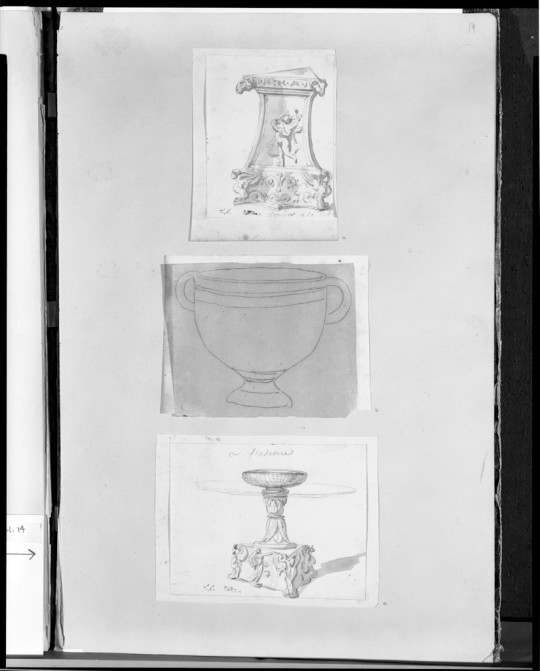
Antique Fountain (The Roman Album), Jacques-Louis David, 1775-1780, Harvard Art Museums: Drawings
Harvard Art Museums/Fogg Museum, Bequest of Grenville L. Winthrop
Size: actual: 12 x 15.3 cm (4 3/4 x 6 in.)
Medium: Black crayon and gray wash on cream antique laid paper, mounted on cream laid paper
https://www.harvardartmuseums.org/collections/object/289332
2 notes
·
View notes
Text
Must-See TV (Episode 2)
And now, for the art history.
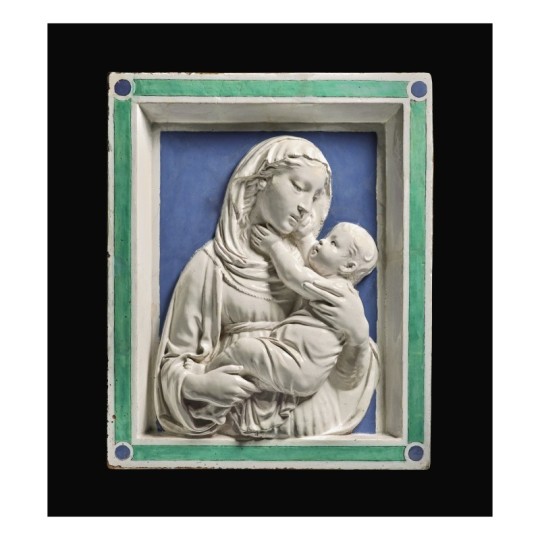
Luca della Robbia (Italian, 1399-1482), Madonna and Child, ca. 1450, tin-glazed terracotta (18½ x 15¾ in.). Photo credit: Sothebys.com.
There were a number of items in Sotheby’s January 28 sale that caught my attention because of their association with Hyde pieces. The first was Lot 2, Luca della Robbi’s terracotta relief, Madonna and Child. Luca (1399-1482) founded a multi-generational family workshop that was famous for its terracotta sculptures covered in a gleaming, pure, white glaze—its formula, a closely-guarded family secret—that made the fired clay pieces impermeable to the elements and gave them the appearance of much more expensive marble. The reliefs were cast in molds, allowing for a degree of mass-production that expanded the clientele for such fine works of art to include the successful merchant and banking class of Renaissance Italy’s major cities.

Luca della Robbia (Italian, 1399-1482), Madonna of the Lilies, ca. 1450-1460, tin-glazed terracotta (20 1/4 × 16 1/8 in.) The Hyde Collection, Glens Falls, New York, Gift of Charlotte Pruyn Hyde, 1971.99. Photography by Michael Fredericks.
Like The Hyde’s Madonna of the Lilies, the Sotheby’s relief was intended for the domestic market. It was undoubtedly used in the home as the focus of private, family devotion to the Virgin and Christ Child, and indeed, Sotheby’s expert Giancarlo Gentilini proposes that the relief was commissioned by Bosio I, Count of Santa Fiora in Tuscany for this wife Cecilia, sometime between 1439 and 1451.
It is striking how intimate the viewer’s relationship with the Madonna and Christ Child is, more so than in our terracotta. So high is the relief carving, the divine pair actually breaks out of their tightly constrained space into our world. The sculpture affirms the Christian belief that God was incarnate in Christ, here the robust child, tenderly held in his mother’s arms. His divinity and her purity are expressed through the terracotta’s unblemished white glaze.
Surprisingly, the two reliefs “met” once. They were both included in an exhibition at the Detroit Institute of Arts in 1938 that was curated by William Valentiner, the museum’s director and Mrs. Hyde’s art advisor. Both sculptures have been praised by experts as being “autograph;” that is, they are so fine in their execution, even though other examples survive, that the hand of the master, Luca, has been discerned over that of his workshop assistants.
Lot 14, Sano di Pietro, Nativity.
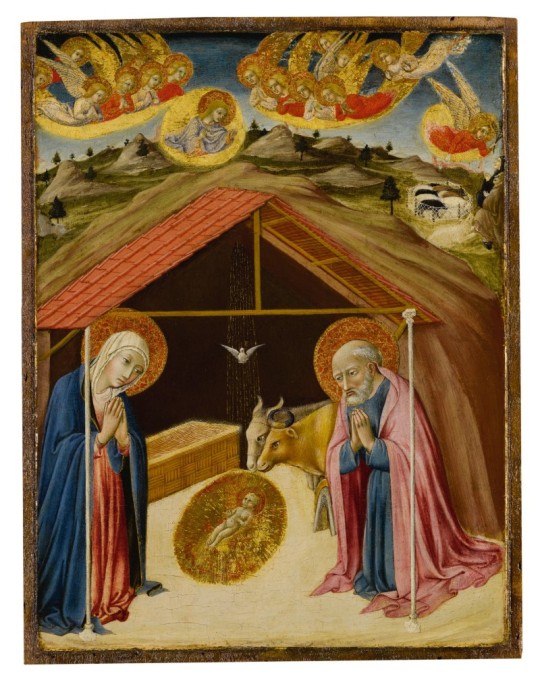
Sano di Pietro (Italian, 1405-1481), Nativity, tempera and gold ground on panel (20 5/8 by 15 7/8 in.). Photo credit: Sothebys.com.
There is a clear resemblance between the form of Virgin Mary’s head in this depiction of the Nativity and that of the Archangel Gabriel’s in The Hyde’s panel that formed one half of an Annunciation scene.
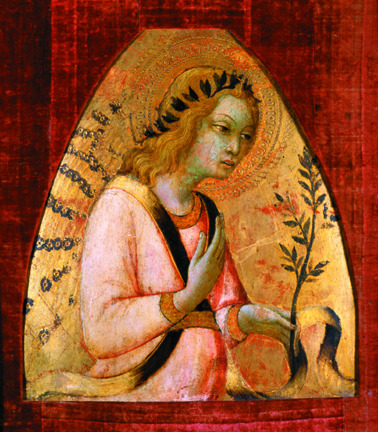
Sano di Pietro (Italian, 1405 - 1481), Angel of the Annunciation, ca. 1450, tempera and gilding on panel (14 1/2 × 13 1/2 in.); The Hyde Collection, Glens Falls, New York, Bequest of Charlotte Pruyn Hyde, 1971.44. Photo credit: Mclaughlinphoto.com.
Sano di Pietro (1405-1481) was a leading painter in Siena in the first part of the fifteenth century. In the Sotheyb’s panel, we have the chance to examine his use of color and composition in constructing narrative scenes. The primary storyline, Christ’s birth in a stable, dominates the foreground. The secondary narrative, the annunciation to the shepherds, occurs in the middle distance. The principal figures, including the ox and ass, are modeled with evenly modulated light. They have a sense of early Renaissance volume and weight lacking in the rather flimsy Gothic architecture of the stable. A brightly colored choir of angels watches over the Christ Child, and God sends down the dove of the Holy Spirit in a shaft of divine light to illuminate the newborn, who lies in an aureole of straw and light that signals His divinity.
There is some debate as to whether this panel was part of a small chapel altarpiece or intended for use in a domestic setting. Last year, a student from Florence wrote to The Hyde asking for particular information about our panel. She thought she might know the altarpiece from which our Angel came. The piecing together of dismembered altarpieces, often by studying physical elements such as the thickness of the panel and the pattern of growth rings, is an emerging field of research. It educates art historians in the more practical and physical aspects of art production. I have tried to follow up, but, as of yet, still await news of her findings.
Lot 15. Sandro Botticelli, Portrait of a Young Man Holding a Roundel.

Sandro Botticelli (Italian, 1444-1510), Portrait of a Young Man Holding a Roundel, n.d., tempera on panel (23 x 15 ½ in.). Photo credit: Sothebys.com
This is the auction item that everyone is talking about. It sold for $80M (with commissions, etc., it came to $92,184,000).
There was little drama in the sale itself. The opening bid was $70M. The sale ended five bids later, in increments of $2M, at $80M. With commissions and fees, the work topped out at over $92M, the most ever spent for a Florentine Renaissance Master.
As in the della Robbia discussed above, the artist uses the architectural framing within the piece to push the figure forward. Through the illusion of a finger extending beyond the painted lower ledge, Botticelli suggests that the young man is real and actually standing in the viewer’s space. Elegance is the watchword for this painting. It is present in Botticelli’s use of line and form and in the artist’s self-assurance and that bestowed upon the figure and character of the sitter. These are qualities that we can sense in The Hyde’s small predella panel depicting the Annunciation.
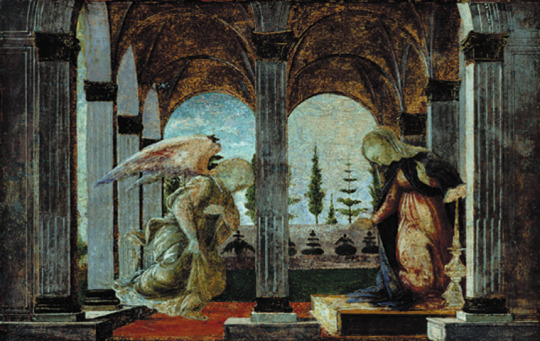
Sandro Botticelli (Italian, 1444-1510), Annunciation, ca. 1492, tempera on panel (7 x 10 9/16 in.). The Hyde Collection, Glens Falls, New York, Gift of Charlotte Pruyn Hyde, 1971.10. Photography by Joseph Levy.
Mary reacts in a graceful and demure manner as Gabriel glides in to the loggia where she was reading her devotional book. The angel’s robes flutter, perhaps a little fussily. Where our sadly abraded panel gives only a hint of Botticelli’s command of delicate shades and tones, the remarkably well-preserved Sotheby’s portrait gives ample evidence of Botticelli’s mastery of tempera painting.
The roundel the young man holds is a very peculiar detail. It is a separate work of art by the Sienese artist Bartolomeo Bulgarini from roughly a century earlier, and it has been pieced into Botticelli’s panel. Quite what Botticelli meant to signify by this is debated by scholars. Was he suggesting a genealogical link between the two, a shared character trait, or perhaps a strong devotion by the young man to the unidentified saint?
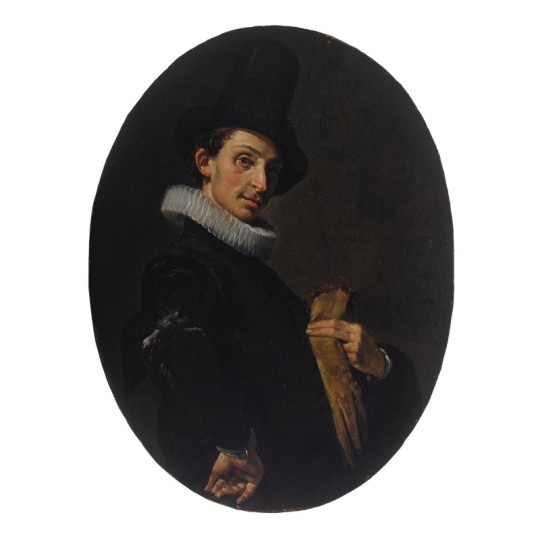
School of Haarlem (Dutch, 1600-1699), Portrait of a young man holding his gloves and wearing a tall hat, his arm akimbo, oil on panel, an oval, (10 by 7 ½ in.). Photo credit: Sothebys.com.
I was curious about the next lot, rather cautiously identified by Sotheby’s as “School of Haarlem, Portrait of a Young Man Holding his Gloves, circa 1615.” I thought immediately of the small oval portrait in Hyde House dining room that we now attribute to the Circle of Frans Hals.
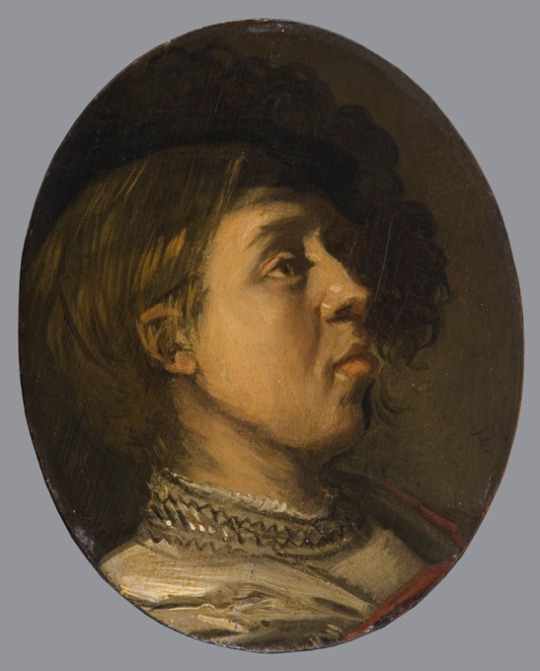
Circle of Frans Hals, (Dutch, 1580-1666), Portrait of the Artist's Son, ca. 1630, oil on panel(7 7/16 × 6 1/2 in.). The Hyde Collection, Glens Falls, New York, Bequest of Charlotte Pruyn Hyde, 1971.21. Photography by Michael Fredericks.
Like ours, the Sotheby’s painting was once thought to be by Frans Hals himself. Hals (1580-1666) is famous for portraits that both in the manner of their execution and in the personality of their sitters, are full of dash and swagger. In the catalogue entry, Sotheby’s favored an attribution to a contemporary of Hals, Willem Buytewech (1591-1624). The market didn’t agree. Bidding started at $30,000 for this small oval work that measures 10 x 7½ inches. It finally came to a stop after helter-skelter bidding at $390,600 (with fees)! There were plenty of bidders, who evidently thought this to be by Frans Hals. Would someone care to reconsider our painting? Like the Sotheby’s piece, the Hyde portrait was authenticated as a Hals by William Valentiner, but subsequently downgraded by several scholars, among them Seymour Slive, who reattributed the Sotheby’s work to Buytewech.

Hubert Robert (French, 1733-1808), View of a Garden with a Large Fountain and View of a Walled Garden Courtyard, n.d., oil on canvas (99¼ x 56¼ in.). Photo credit: Sotheby’s.com
It was a detail in Lot 39, the eponymous fountain in Hubert Robert’s View of a Garden with a Large Fountain, that caught my attention. It recalled to mind the vertical jet fountain in The Hyde’s drawing, Château in the Bois de Boulogne, ca. 1780.

Hubert Robert (French, 1733-1808), Château in the Bois de Boulogne, ca. 1780, graphite on paper (9 3/16 x 15 3/4 in.). The Hyde Collection, Glens Falls, New York, Bequest of Charlotte Pruyn Hyde, 1971.103. Photography by Steven Sloman.
Such powerful vertical jets of water first became popular in French garden design at Versailles, where they symbolized the power of the Sun King. By the eighteenth-century, pleasure rather than power was the primary objective of art, architecture, and garden design. Robert was popular among the French aristocratic elite for painting large-scale decorative schemes for their grand houses. He often depicted pleasure gardens, bucolic scenes, and romantic ruins. In 1778, the painter was appointed designer of the king’s gardens. In the Sotheby’s piece the vertical jet of water makes a suitable compositional focal point in a panel that measure 8’ 3” in height.
A similar jet fountain appears in a decorative room panel signed and dated by Robert in 1773, executed for the financier Jean-François Bergeret de Frouville. Exhibited at the Salon of 1775, it was entitled The Portico of a Country Mansion, near Florence, and is now in the possession of the Metropolitan Museum of Art.

Hubert Robert (French, 1733-1808), The Portico of a Country Mansion, near Florence, 1773, oil on canvas (80 3/4 x 48 1/4 in.). The Metropolitan Museum of Art, Bequest of Lucy Work Hewitt, 1934, 35.40.2. Photo credit: Metmuseum.org.
In our drawing, Robert drew a actual fountain, one that dominated the parterre behind the Château de Bagatelle in the Bois de Boulogne, on the outskirts of Paris. The château was built by the Comte d’Artois, the brother of Louis XVI. Marie Antoinette had bet him that he could not build his little pleasure palace within three months. Designed by the architect Francois-Joseph Belanger (1744-1818) in the Neoclassical Style, the party house was constructed in just 63 days. Robert decorated its salle de bains with six panels that depicted the Italian countryside, classical buildings, and various forms of entertainment, like dancing, swinging, and bathing. These panels, too, now reside at the Met.
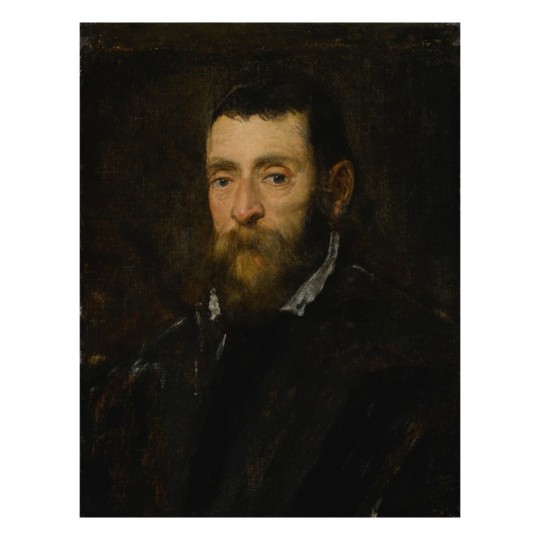
Jacopo Robusti, called Jacopo Tintoretto (Italian, 1518-1594), Portrait of a Bearded Man, 1560s, oil on canvas (23 3/8 x 18 in.). Photo credit: Sothebys.com.
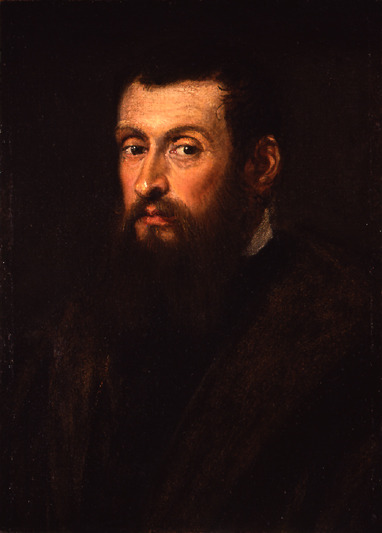
Jacopo Robusti, called Jacopo Tintoretto (Italian, 1518-1594), Portrait of the Doge Alvise Mocenigo, ca. 1570, oil on canvas (21 1/2 x 15 1/2″); The Hyde Collection, Glens Falls, New York, Gift of Charlotte Pruyn Hyde,, 1971.49.
I have taken this last work out of turn, but I thought I would end with a comparison of hipster beards. Lot. 23 was Jacopo Tintoretto’s, Portrait of a Bearded Man. It was probably painted within a decade of The Hyde’s Portrait of the Doge Alvise Mocentigo (ca. 1570). The two share many traits. They are both portraits of self-possessed, wealthy men. Their dark somber clothing signals that. They dress according to the dictates of the style-setter for courtiers, Baldasare Castiglione (1478-1529), who wrote that “ the most agreeable color is black, and if not black, then at least something fairly dark.” Presented at only bust length, their torsos turned slightly away from the viewer but engaging directly with their eyes, these portraits convey a sense of intimacy and dialogue. The sitter’s face emerges from a dark background, its features modeled in warm lighting.
There are no known preparatory drawings by Tintoretto for portraits. He seems to have worked directly on the canvas before him. This would have appealed to his primarily male sitters because it undoubtedly reduced the number and length of sittings. As a side note, while it was acceptable for a man to sit or his portrait in a painter’s studio, it was not for a woman. Inconveniently for the portraitist and patron, the painter had to set up his easel and paint with oils in a female sitter’s house. Thus, the cost of a woman’s portrait was often more expensive. The conservative taste of the Venetian elite ensured that the compositional characteristics of this portrait had not changed in a generation. Where Tintoretto excelled was in the mastery and boldness of his brushstrokes and the accompanying speediness of execution. Notice, particularly in the Sotheby’s painting, the freedom and liveliness of the white brushstrokes with which he defines the shirt collar, distinguishes between the sitter’s beard and dark clothing, and spatially locates the different elements of the body within the otherwise ill-distinguished depth of the painting. Patrons valued Tintoretto’s masterly touches with the brush, the contrasts between areas of thickly applied paint and those where it is so thinly applied that one can discern the weave of the canvas. Working with accepted conventions, Tintoretto was able to convey something of what made his bearded male sitter unique.
There is always something of the wishful shopper, when I flip through a sales catalogue. But I am always excited when I discover something that relates to a work in our collection, and I ultimately never cease to marvel at the judicious purchases made by Louis and Charlotte Hyde.
#hydecollection#sotheby's#frans hals#sano di pietro#luca della robbia#botticelli#hubert robert#Tintoretto
3 notes
·
View notes
Photo

|Santa Maria della Concezione Crypts| __________________________________________ The #crypts of Capuchin friars decorated with the #bones of over 4,000 friars, including an entire "crypt of pelvises". __________________________________________ In 1775, The Marquis de Sade wrote of it, “I have never seen anything more striking”. Granted, the crypt was to his tastes. Mark Twain wrote about it in his 1869 book Innocents Abroad. When Twain asked one of the monks what would happen when he died, the monk responded, “We must all lie here at last”. And lie there they do. Some 4,000 Capuchin friars who died between 1528 and 1870 are still lying, hanging, and generally adorning the Santa Maria della Concezione crypt in Rome. In 1631, the Capuchin friars, so-called because of the “capuche” or hood attached to their religious habit, left the friary of St. Bonaventure near the Trevi Fountain and came to live at Santa Maria della Concezione, of which only the church and crypt remain. They were ordered by Cardinal Antonio Barberini (the Pope’s brother and a member of the Capuchin order) to bring the remains of the deceased friars along with them to their new home so that all the Capuchin friars might be in one place. Rather than simply burying the remains of their dead brethren, the monks decorated the walls of the crypts with their bones as a way of reminding themselves that death could come at any time. A plaque in the crypt reads, “What you are now, we once were; what we are now, you shall be”. The ossuary contains a crypt of skulls, a crypt of leg bones, and perhaps the oddest—a “crypt of pelvises”. Mummified monks were dressed in friar’s clothes and hung from the walls and ceiling. With the addition of electricity, light fixtures were incorporated into some of the hanging monks, bringing a new meaning to the phrase “the eternal light”. A particular #highlight of the crypt is the #skeleton enclosed in an oval of bones holding a scythe and scales—tools made entirely out of, yes, bones. The crypt is said to have been the inspiration for Sedlec Ossuary in the Czech Republic. __________________________________________ @be_Amyas #mypersonalselection #mypersonaltripaboutart (at Cripta-Ossario Frati Cappuccini-Roma Via Veneto) https://www.instagram.com/p/CA07jGeHhuT/?igshid=yc0se2yqeizb
1 note
·
View note
Text
The families of Mahmud I and Osman III
Neither Mahmud I or his successor Osman III had children, prompting Sakaoğlu to think that they could have been castrated during their imprisonment in the kafes. Osman III was 55 years old when he became sultan and in weak health, so this may have been the reason why he did not father any children.
Mahmud I (r. 1730-1754)
Ayşe Başkadın: according to Sicill-i Osmani. She died in 1746, probably his only consort to die during his reign. She built a primary school in Çörekçikapısı in Fatih. It is unknown where she was buried. Alderson calls her Hace, which means that she had undergone the pilgrimage to Mecca (by proxy). According to Öztuna she was the Second Imperial Consort instead.
Hâce Ayşe Kadın: Öztuna thinks she may have been a different consort, though dead in 1746 as well.
Hâtem Başkadın: shown in Sicill-i Osmani. She probably acquired the title of Senior Consort after Ayşe Kadın's death. She died during Mustafa III's reign (in 1769), and was buried in the Ayazma Mosque in Üsküdar. Öztuna thinks she may have been Second Imperial Consort from 1746 to 1754.
Hâce Â'lî-cenâb Baş-Kadın: according to Öztuna, she was the Senior Consort (tenure: 1730-1754). She built schools and fountains around the Fatih Mosque. She died in 1775 and was buried in the Yeni Camii.
Hâce Verd-i nâz Kadın: Fourth or Fifth Imperial Consort. As her date of death is pretty late (16.12.1804), it has been suggested that she may have entered Mahmud I's harem later than his other consorts. She built a school and a fountain in Murâdpaşa, and another fountain in Galata. She was buried in Şehzâdebaşı.
Hadîce Râmî Kadın: Sixth Imperial Consort. She built a school and a fountain in Beşiktaş. A year after the death of Mahmud I, she married Haremeyn Inspector Mustafapaşazade İbrahim Bey. She died on 16 January 1780.
Tiryâl Kadın: in Sicill-i Osmani she was indicated as an ikbal but Alderson and Öztuna insist that she was an Imperial Consort. She died in 1785 or in 1789.
Hadîce Kadın: no information available.
Râziye Kadın: no information available.
Meyyâse Hanım: Baş-Ikbâl.
Fehmî Hanım: Second Ikbal.
Sirri Hanım: either a consort or a kalfa
Habbâbe Hanım: either a consort or a kalfa
Osman III (r. 1754-1757)
Leylâ Baş-Kadın: Öztuna says that a few months after becoming a widow, she married Hacı Mehmed Emîn Bey and had a son with him, Feyzullâh Bey. She died in 1794 and was buried in Üsküdar.
Zevki Kadın: Third Imperial Consort. During the short reign of her husband, she founded several reconstructions throughout Istanbul and built a fountain in Fındıklı in Turkish Barouque style. It is not known when she died or where she was buried.
Ferhunde Emîne Kadın: not mentioned in Sicill-i Osmani or by Alderson but was found by Uluçay in a document in the Archives of Topkapı Palace. She died in 1791, maybe in August.
sources:
- M. Çağatay Uluçay - Padişahların Kadınları ve Kızları
- Yılmaz Öztuna - Devletler ve Hanedanlar Cilt 2
- Necdet Sakaoğlu - Bu Mülkün Kadın Sultanları
#history#ottoman history#mahmud i#osman iii#*consortsandchildren#ayse kadin (mahmud i)#hatem kadin (mahmud i)#alicenab kadin (mahmud i)#verdinaz kadin#hatice rami kadin#tiryal kadin#hatice kadin (mahmud i)#raziye kadin (mahmud i)#meyase hanim#fehmi hanim#sirri hanim#habbabe hanim#leyla kadin#zevki kadin#ferhunde enime kadin
18 notes
·
View notes